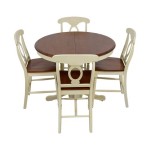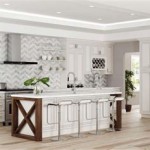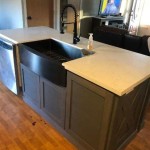All-In-One Kitchen Sink and Countertop: Streamlining Design and Functionality
The all-in-one kitchen sink and countertop, often realized in materials like stainless steel, quartz composite, or solid surface, represents a significant innovation in kitchen design. This integrated approach eliminates the traditional seam between the sink and countertop, offering a seamless, hygienic, and aesthetically pleasing solution for modern kitchens. This article will explore the benefits, materials, design considerations, installation processes, and maintenance procedures associated with all-in-one kitchen sink and countertop systems.
Enhanced Hygiene and Cleanliness
One of the primary advantages of an all-in-one kitchen sink and countertop is the reduction of bacteria and mold growth. Traditional kitchen setups, where the sink is mounted onto the countertop, typically feature a caulked seam. This seam, despite best efforts to maintain it, can become a breeding ground for microorganisms due to trapped moisture and food particles. The seamless nature of an all-in-one design eliminates this vulnerable area, simplifying cleaning and preventing the accumulation of harmful bacteria. A smooth, non-porous surface further contributes to hygiene, as it resists staining and absorption of liquids, making spills easier to clean and reducing the risk of cross-contamination.
The absence of a visible seam also minimizes the likelihood of water damage to the cabinetry below the sink. In traditional kitchens, a compromised seal around the sink can lead to slow leaks that gradually damage the cabinet structure, resulting in costly repairs. An all-in-one system mitigates this risk because the sink and countertop are fused together, creating a watertight barrier. The seamless design allows for easy wiping and disinfection, promoting a healthier kitchen environment overall. Regular cleaning with appropriate non-abrasive cleaners will maintain the hygiene and appearance of the integrated sink and countertop.
Furthermore, certain materials used in all-in-one systems, such as solid surface, can be inherently antimicrobial. These materials contain additives that inhibit the growth of bacteria and mold, providing an extra layer of protection against microbial contamination. This is particularly beneficial in high-usage kitchens where food preparation is frequent, and maintaining a sanitary environment is critical.
Design Flexibility and Aesthetic Appeal
All-in-one kitchen sink and countertops offer a wide range of design possibilities, allowing for customization to suit various kitchen styles and layouts. Manufacturers offer a variety of sink bowl configurations, including single-bowl, double-bowl, and workstation sinks with integrated accessories such as cutting boards and colanders. The shape and size of the sink can be tailored to meet specific needs, whether it's a large, deep sink for washing oversized pots and pans or a smaller, shallower sink for prep work.
The material selection significantly impacts the aesthetic of the kitchen. Stainless steel offers a sleek, modern look and is known for its durability and resistance to stains and corrosion. Quartz composite provides a more natural stone appearance and is available in a wide range of colors and patterns. Solid surface materials can be molded into virtually any shape and color, allowing for seamless integration with the overall kitchen design. These materials can also mimic the look of natural stone or concrete, providing aesthetic versatility.
Beyond the sink bowl configuration and material choice, the countertop itself can be customized with different edge profiles, backsplashes, and integrated drainboards. These design elements can enhance the functionality and visual appeal of the kitchen. For instance, a built-in drainboard allows for convenient air-drying of dishes, while a custom backsplash protects the wall from splashes and adds a decorative touch. The seamless integration of these features creates a cohesive and visually striking kitchen design.
Installation and Material Considerations
The installation process for an all-in-one kitchen sink and countertop differs considerably from that of a traditional sink installation. Due to the integrated nature of the system, precise measurements and careful handling are crucial. Typically, the installation is best performed by a qualified professional to ensure a proper fit and avoid any damage to the countertop or sink. The weight of the integrated unit can also be a factor, requiring adequate support and reinforcement within the cabinetry.
Before installation, the existing countertop and sink must be removed, and the cabinet base must be leveled and prepared to receive the new all-in-one unit. Special attention should be paid to plumbing connections to ensure proper drainage and water supply. The installer will typically use silicone sealant to create a watertight barrier between the countertop and the cabinet base.
Material selection plays a critical role in the longevity and performance of the all-in-one system. Stainless steel is a popular choice due to its durability, stain resistance, and heat resistance. However, it can be prone to scratches and dents. Quartz composite is a durable and non-porous material that resists scratches, stains, and heat. It is available in a wide range of colors and patterns. Solid surface materials are also durable and non-porous, but they can be more susceptible to scratches and heat damage than quartz composite. The cost of each material varies, with stainless steel generally being the most affordable and solid surface and quartz composite being more expensive.
When choosing a material, it is important to consider the intended use of the kitchen, the desired aesthetic, and the budget. High-traffic kitchens that are used for frequent cooking and food preparation may benefit from the durability and stain resistance of quartz composite or stainless steel. Kitchens with a more relaxed atmosphere may be well-suited to the aesthetic flexibility of solid surface materials. Regardless of the material chosen, it is important to follow the manufacturer's recommendations for cleaning and maintenance to ensure the longevity and beauty of the all-in-one kitchen sink and countertop.
Specific considerations for each material include:
* Stainless Steel: Gauge thickness impacts dent resistance. Higher gauges (thinner steel) are more susceptible to damage. Look for 16-gauge or lower for better durability. Sound dampening features can reduce noise from water and dishes. * Quartz Composite: The ratio of quartz to resin affects durability and stain resistance. Higher quartz content generally indicates a more durable product. Consider the color and pattern carefully, as repairs to chips or scratches may be more noticeable in certain designs. * Solid Surface: While repairs are often possible with solid surface materials, darker colors may show scratches more readily. Consider the heat resistance of the specific solid surface product, as some are more prone to damage from hot pots and pans.In addition to the counter and sink material, consider the faucet compatibility. Most all-in-one units come pre-drilled with faucet holes, but confirming the hole configuration matches the desired faucet is essential. Different faucet styles require different hole configurations (e.g., single hole, widespread, bridge faucet). Choosing a faucet that complements the overall design of the kitchen is crucial.
The size and depth of the sink bowl are also important considerations. A deeper sink bowl is better suited for washing large pots and pans, while a shallower sink bowl may be more convenient for everyday tasks such as rinsing dishes. Consider the frequency and type of tasks performed in the sink when making this decision. Additionally, the overall dimensions of the countertop must be carefully considered to ensure it fits within the available space in the kitchen.
In conclusion, the selection and installation of an all-in-one kitchen sink and countertop are multifaceted processes requiring careful planning and execution. By considering the factors outlined above, homeowners can create a functional, aesthetically pleasing, and hygienic kitchen space that meets their specific needs and preferences.

One Piece Sink And Countertop Designs For Your Kitchen

Corian For Kitchen Sinks

One Piece Sink And Countertop Designs For Your Kitchen

One Piece Sink And Countertop Designs For Your Kitchen

Kraus Loften 33 In Drop Single Bowl 18 Gauge Stainless Steel Kitchen Sink With Pull Down Faucet Matte Black Kht410 Kpf 1610mb The Home

Kraus Kwt310 33 Pgm Kore Workstation Inch Topmount Drop In 16 Gauge Stainless Steel Single Bowl Kitchen Sink Pvd Gunmetal

Ruvati 32 Inch Workstation Ledge Undermount 16 Gauge Stainless Steel Kitchen Sink Single Bowl Rvh8300 Usa

Glacier Bay 30 In Drop Single Bowl 18 Gauge Gunmetal Black Stainless Steel Workstation Kitchen Sink With Spring Neck Faucet Acs3022a1t Fw

Boelon Luxury Kitchen Sink With Digital Display And Waterfall Design

Integrated Sink Design Pros Cons Of Sinks Into Countertops








